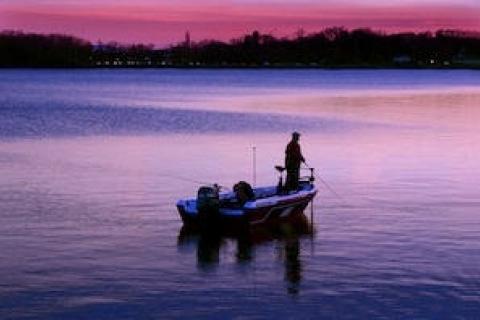
 Every time I leave the launch on Lake St. Clair, I can't help stopping to wonder why more people don't take advantage of the Great Lakes' largest predator. St. Clair's enormous ecosystem produces trophies that would awe the most experienced anglers. Yet, the fishing pressure is unbelievably light. I've been fortunate to spend the past 20 years decoding the annual patterns these fish follow.
Every time I leave the launch on Lake St. Clair, I can't help stopping to wonder why more people don't take advantage of the Great Lakes' largest predator. St. Clair's enormous ecosystem produces trophies that would awe the most experienced anglers. Yet, the fishing pressure is unbelievably light. I've been fortunate to spend the past 20 years decoding the annual patterns these fish follow.
Trolling for muskellunge is a high-demand sport that requires a run-and-gun approach. To be proficient, you must adapt to changing conditions. The fish are ambush predators that feed where their next meal hangs out. Finding their forage will put you one step closer to your quarry.
The flowing waters of the St. Clair River have carved a very unique underwater landscape. The swirling currents have created large flats with sporadic points and slight drops that ultimately descend to the channel that divides the U.S. and Canada.
A GPS incorporated with Navionics is by far the most important piece of equipment for a muskie hunter. I've found that if I'm marking forage fish in the top half of the water column, they are on the feed. This situation will have predators on the move as well. Marking these areas and trolling in different directions will produce fish that are on the hunt. Over time, you will create a database for future use.
Early in the season, the immense weed beds are beat down from the long winter and have just begun to regrow. The muskie are in the post-spawn and are hungry. The majority of their diet consists of sheephead, smallmouth, walleye, perch and any other creature that swims. These weary fish congregate on the breaks where the weeds and cover are thickest.
As the summer progresses, the underwater weeds can literally reach the surface in 13 feet to 16 feet of water, limiting the area that can be trolled effectively. Luckily, muskie have a bad habit of hunting the edges of the lush green underwater forests and the channels that dissect the 275,000-acre body of water.
Understanding wind direction in correlation with lake currents will keep your lines free from floating weeds, which have been torn from their roots from wind, weather and props. This important factor will determine where you may fish on any given day.
A variety of lures are needed to cover a muskie's vast environment. Running multiple lines with large offerings require lures that track well at fast speeds and others that can handle the turbulent prop wash. I've found that on my boat, 10 rods work well, but sometimes I'll only run six when floating weeds create issues.
Every rod on the boat suits a purpose. In good conditions, each side of my rig consists of three lines running off big planer boards, one down rod out the side, and one in the prop wash, covering no less than 40 yards of water at any time and up to 100 yards when conditions allow. The goal is to cover as much ground as possible, literally raking large expanses of water.
Recently, I had the opportunity to field test a few new lure designs produced by Bass Pro Shops. The XPS Deal Sealer Buck Tail has a two-blade design that helps slice and clear unwanted weeds. The bait has an ounce of lead incorporated in the design that keeps it down at high speeds.
Running the buck tails off the planer boards with a four-ounce inline weight and a five-foot leader proved to be a lethal tactic for pulling fish out of foliage that nearly reaches the surface. These muskie magnets will draw fish right in the wash as well. The only modification is using a heavier weight to help get the attractive offering into the strike zone.
The second lure was the Off Shore Saltwater Down Under. These deep-diving crank baits track extremely well at any speed and can be used to reach any depth needed. They can be run off the boards, letting the amount of line out dictate how deep they run.
The Down Under is a solid lure that adapts to any position on the boat, whether it's in the prop wash, on the planers or on the outside rods. They dredge with powerful accuracy, pulling any hungry or inquisitive fish to their capture in the net.
When the crankbait bite is on, the Rapala Super Shad Rap series is a go-to lure as well. Muskie have a hard time resisting this well-built lure. They track well in any rod holder and really put fish on deck. Every trip, I have several ripping through the water behind the boards.
Years of caught fish and marked way-points have created my map to success, but running the right lures, with the right presentation, in the right location, can put anyone on the fish. Lake St. Clair, at this point in time, has the healthiest population of musky that I have seen in the last 20 years. If musky intrigue you, now is the time to engage!
by Dave Lee
- 4311 views

